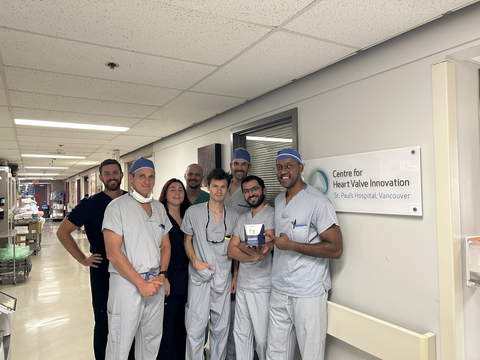BRISBANE, Australia & MINNEAPOLIS– Anteris Technologies Ltd (Anteris or the Company) (ASX: AVR, OTC: ANTTY) reported today that DurAVR™ THV, a new class of biomimetic heart valve and the world’s only balloon-expandable, single-piece transcatheter aortic valve was implanted in a second successful Valve-in-Valve (ViV) procedure as part of Health Canada’s Special Access Program (SAP).
A ViV procedure is required for patients with a life-threatening situation wherein their current bioprosthetic aortic valve is failing due to calcification or structural deterioration, and a new heart valve must be implanted inside the failing valve. These patients are at high risk for another surgery and require a minimally invasive treatment option. Currently available commercial products can leave patients with a high risk of remaining in a diseased state post-procedure, with unsatisfactory high gradients. Canada’s SAP exists so that life-saving technology not currently available for commercial use in Canada can be provided when no other commercially available alternatives are suitable.
Dr Janar Sathananthan, an interventional cardiologist at Vancouver General and St Paul’s Hospital and a world expert on bench testing the hemodynamic effects of different valves used in ViV procedures, made the request to Health Canada to make DurAVR™ THV available for this procedure.
DurAVR™ THV was implanted in a 79-year-old female who was previously implanted with a Trifecta surgical valve that had severely degenerated, causing debilitating symptoms. The intraoperative results after DurAVR™ THV was implanted were phenomenal, with a mean pressure gradient of 7mmHg, restoring near-normal physiology. The patient was safely discharged less than 24 hours after the procedure.
Dr. Sathananthan commented:
“DurAVR™ THV performed exceptionally well during this complex ViV procedure. Today’s case demonstrated what we saw in preclinical testing, that DurAVR™ THV has the potential to offer superior gradients for ViV patients. This is a great result in a small surgical valve at high risk for elevated gradients.”
Dr. Chris Meduri, Anteris Technologies CMO, Commented:
“DurAVR™ THV has been purposely designed in close partnership with the world’s leading TAVR physicians as a solution to achieve near-normal blood flow. As we continue to progress and build the body of clinical evidence for the DurAVR™ THV system, we believe that the unique design of this valve is behind the exceptional best-in-class results and will be the ideal choice for patients with both native severe aortic stenosis and those needing a ViV procedure. As Dr. Sathananthan has stated, these results do not come as a surprise. Extensive preclinical work in partnership with a large number of leading physicians has demonstrated a superior hemodynamic result compared to commercially available products, both in native aortic stenosis and in valve-in-valve procedures. With a rapidly growing number of degenerating AVRs, this valve will have a dominant role in treating these patients.”
Wayne Paterson, Anteris Technologies CEO Commented:
“As the body of evidence is growing rapidly with our Europe and North American patients, we are seeing results that support both the clinical and commercial case for DurAVR™ THV. These outstanding results are not only best in class but deliver options for patients that were previously not seen with existing products. Our continued clinical success both in the treatment of native aortic stenosis patients as well as the complicated and difficult-to-treat valve-in-valve patients is building confidence within the global physician community. With the recent global withdrawal of an aortic valve replacement product due to accelerated failure leaving tens of thousands of patients with a deteriorating valve, there is a rapidly growing need for better treatment options for this specific patient group which may account for 30% (USD 3 BN) in the years ahead.”
DurAVR™ THV continues to be investigated in a clinical trial setting for severe aortic stenosis patients in two Early Feasibility Studies (EFS) being run in the US (ClinicalTrials.gov NCT05712161) and Europe (Clinicaltrials.gov NCT05182307) at this time.


